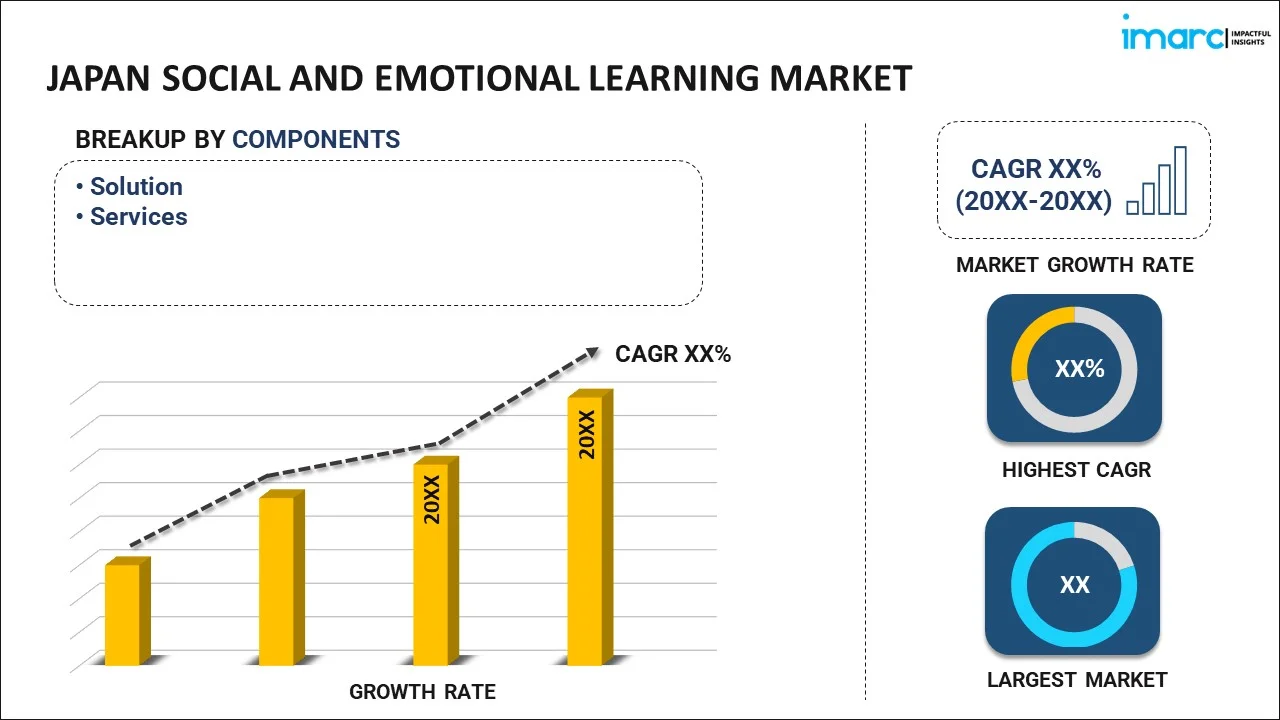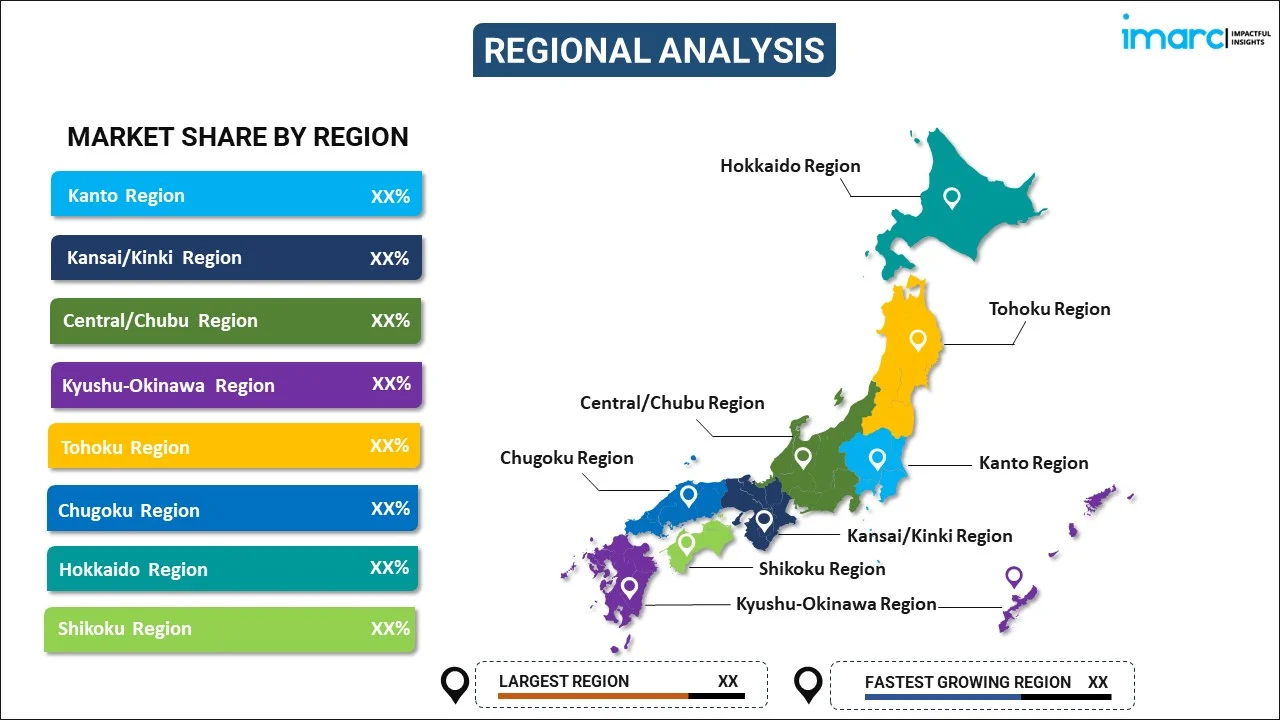
Japan Social and Emotional Learning Market Report by Component (Solution, Services), Type (Web-based, Application), End User (Pre-K, Elementary School, Middle and High School), and Region 2025-2033
Market Overview:
Japan social and emotional learning market size reached USD 164.8 Million in 2024. Looking forward, IMARC Group expects the market to reach USD 1,038.9 Million by 2033, exhibiting a growth rate (CAGR) of 20.7% during 2025-2033. The increasing prevalence of mental health issues among students, including stress, anxiety, depression, and social isolation, coupled with the unmet medical need for preventive and supportive measure, is primarily driving the market.
|
Report Attribute
|
Key Statistics
|
|---|---|
|
Base Year
|
2024 |
|
Forecast Years
|
2025-2033
|
|
Historical Years
|
2019-2024
|
| Market Size in 2024 | USD 164.8 Million |
| Market Forecast in 2033 | USD 1,038.9 Million |
| Market Growth Rate (2025-2033) | 20.7% |
Social and emotional learning (SEL) is an educational framework that emphasizes the development of essential social and emotional skills in individuals, particularly students. SEL programs aim to cultivate competencies such as self-awareness, self-regulation, empathy, and effective communication. These skills help individuals build healthier relationships, manage emotions, and make responsible decisions. SEL is integral to holistic education, fostering emotional intelligence and promoting positive behavioral outcomes. It equips students with tools to navigate life's challenges, reduce stress, and enhance overall well-being. SEL also contributes to creating a more inclusive and supportive school environment, reducing incidents of bullying, and improving classroom behavior and academic performance. Educators and parents play crucial roles in implementing SEL, as they help nurture these skills in children and adolescents. By prioritizing SEL, schools and communities can foster emotionally resilient individuals who are better prepared to succeed academically and thrive in their personal and professional lives.
Japan Social and Emotional Learning Market Trends:
The social and emotional learning market in Japan is gaining significant traction in the education sector due to several key drivers. Firstly, research has consistently highlighted the profound impact of SEL on students' academic performance and overall well-being. Consequently, educators and policymakers are increasingly recognizing the necessity of incorporating SEL programs into school curricula. Moreover, the growing awareness of mental health issues among students has prompted a greater emphasis on SEL. As societal pressures mount, students face heightened stress and anxiety levels, making SEL an essential tool to help them navigate these challenges effectively. This heightened awareness has driven schools and institutions to prioritize SEL to address the emotional needs of their students. Additionally, the advent of technology and remote learning has catalyzed the demand for SEL resources. Furthermore, SEL aligns with the evolving needs of the workforce, where interpersonal skills and emotional intelligence are highly valued. This connection between SEL and future employability, which has encouraged its integration into education, is expected to drive the social and emotional learning market in Japan during the forecast period.
Japan Social and Emotional Learning Market Segmentation:
IMARC Group provides an analysis of the key trends in each segment of the market, along with forecasts at the country level for 2025-2033. Our report has categorized the market based on component, type, and end user.
Component Insights:

- Solution
- Services
The report has provided a detailed breakup and analysis of the market based on the component. This includes solution and services.
Type Insights:
- Web-based
- Application
A detailed breakup and analysis of the market based on the type have also been provided in the report. This includes web-based and application.
End User Insights:
- Pre-K
- Elementary School
- Middle and High School
The report has provided a detailed breakup and analysis of the market based on the end user. This includes pre-K, elementary school, and middle and high school.
Regional Insights:

- Kanto Region
- Kansai/Kinki Region
- Central/ Chubu Region
- Kyushu-Okinawa Region
- Tohoku Region
- Chugoku Region
- Hokkaido Region
- Shikoku Region
The report has also provided a comprehensive analysis of all the major regional markets, which include Kanto Region, Kansai/Kinki Region, Central/ Chubu Region, Kyushu-Okinawa Region, Tohoku Region, Chugoku Region, Hokkaido Region, and Shikoku Region.
Competitive Landscape:
The market research report has also provided a comprehensive analysis of the competitive landscape in the market. Competitive analysis such as market structure, key player positioning, top winning strategies, competitive dashboard, and company evaluation quadrant has been covered in the report. Also, detailed profiles of all major companies have been provided.
Japan Social and Emotional Learning Market Report Coverage:
| Report Features | Details |
|---|---|
| Base Year of the Analysis | 2024 |
| Historical Period | 2019-2024 |
| Forecast Period | 2025-2033 |
| Units | Million USD |
| Scope of the Report | Exploration of Historical Trends and Market Outlook, Industry Catalysts and Challenges, Segment-Wise Historical and Future Market Assessment:
|
| Components Covered | Solution, Services |
| Types Covered | Web-based, Application |
| End Users Covered | Pre-K, Elementary School, Middle and High School |
| Regions Covered | Kanto Region, Kansai/Kinki Region, Central/ Chubu Region, Kyushu-Okinawa Region, Tohoku Region, Chugoku Region, Hokkaido Region, Shikoku Region |
| Customization Scope | 10% Free Customization |
| Post-Sale Analyst Support | 10-12 Weeks |
| Delivery Format | PDF and Excel through Email (We can also provide the editable version of the report in PPT/Word format on special request) |
Key Questions Answered in This Report:
- How has the Japan social and emotional learning market performed so far and how will it perform in the coming years?
- What has been the impact of COVID-19 on the Japan social and emotional learning market?
- What is the breakup of the Japan social and emotional learning market on the basis of component?
- What is the breakup of the Japan social and emotional learning market on the basis of type?
- What is the breakup of the Japan social and emotional learning market on the basis of end user?
- What are the various stages in the value chain of the Japan social and emotional learning market?
- What are the key driving factors and challenges in the Japan social and emotional learning?
- What is the structure of the Japan social and emotional learning market and who are the key players?
- What is the degree of competition in the Japan social and emotional learning market?
Key Benefits for Stakeholders:
- IMARC’s industry report offers a comprehensive quantitative analysis of various market segments, historical and current market trends, market forecasts, and dynamics of the Japan social and emotional learning market from 2019-2033.
- The research report provides the latest information on the market drivers, challenges, and opportunities in the Japan social and emotional learning market.
- Porter's five forces analysis assist stakeholders in assessing the impact of new entrants, competitive rivalry, supplier power, buyer power, and the threat of substitution. It helps stakeholders to analyze the level of competition within the Japan social and emotional learning industry and its attractiveness.
- Competitive landscape allows stakeholders to understand their competitive environment and provides an insight into the current positions of key players in the market.
Need more help?
- Speak to our experienced analysts for insights on the current market scenarios.
- Include additional segments and countries to customize the report as per your requirement.
- Gain an unparalleled competitive advantage in your domain by understanding how to utilize the report and positively impacting your operations and revenue.
- For further assistance, please connect with our analysts.
 Inquire Before Buying
Inquire Before Buying
 Speak to an Analyst
Speak to an Analyst
 Request Brochure
Request Brochure
 Request Customization
Request Customization




.webp)




.webp)












